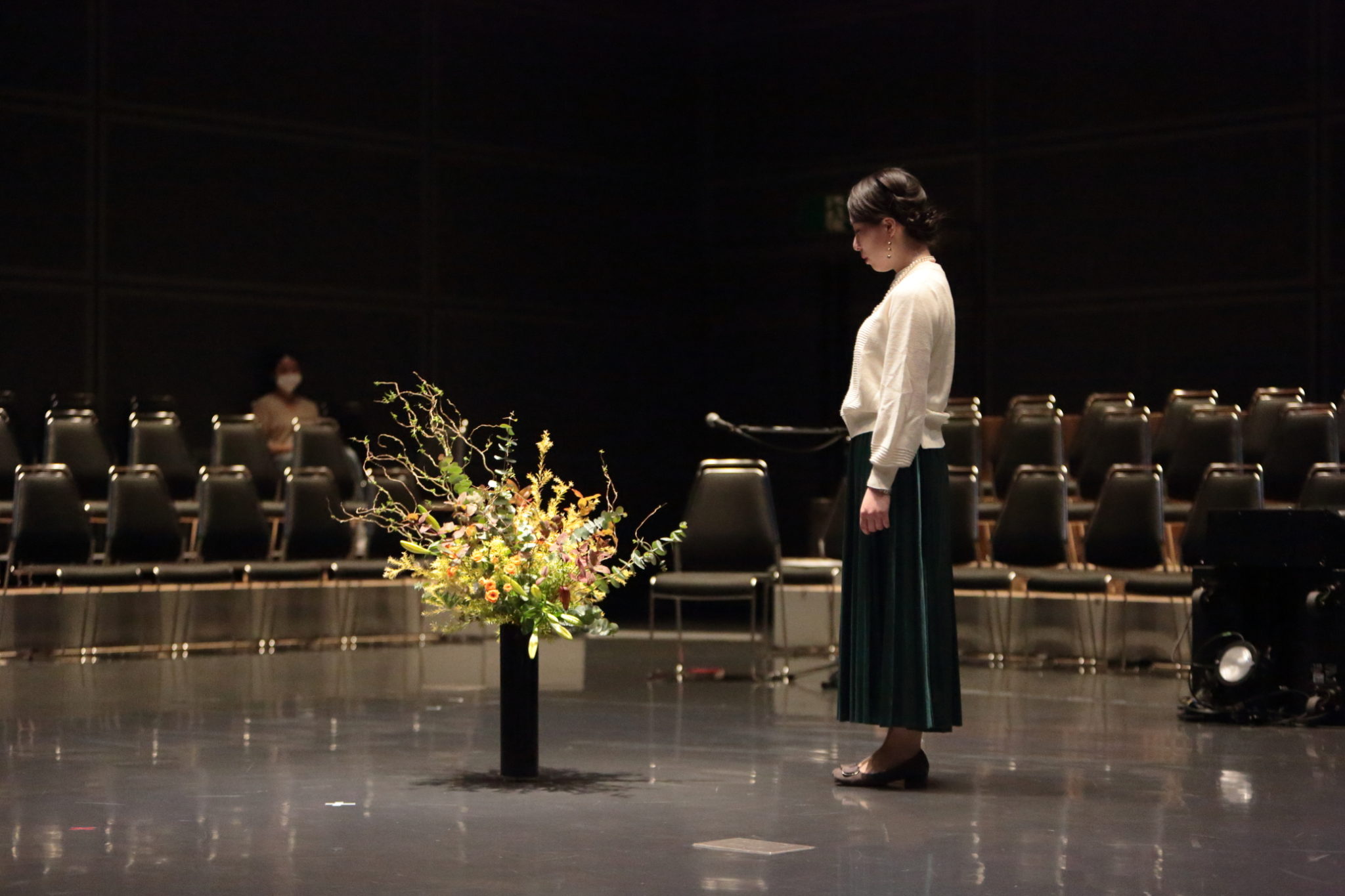Born in 1981. Ph.D. (Information Studies), after working as a researcher at NTT InterCommunication Center (ICC), co-founder of Dividual, Inc., currently a professor at Waseda University, Faculty of Letters, Arts and Sciences. His research focuses on the relationship between technology, humans, and more-than-human worlds. He leads the Ferment Media Research group to develop “Nukabot,” a fermentation robot that they initially exhibited for “Broken Nature” at XXII La Triennale Milano (2019.3.1~9.1). As the art unit dividual inc. (with Takumi Endo), they exhibited “Last Words / TypeTrace” at Aichi Triennale 2019 “Tame Y/Our Passion” (2019.8.1~10.1), where they collected will writing processes from more than 2,000 people. From October 2020 to June 2021, he served as the exhibition director of 21_21 DESIGN SIGHT “traNslatioNs – Understanding Misunderstanding.” His recent publications include “Modern Japanese Literature as Commons” (East Press) and “Mirai wo tsukuru kotoba: wakariaenasa wo tsugnagu tame ni” (Words that Create the Future: To Connect the Unintelligible) (Shinchosha, Inc.). His supervised translation books include Sandor Katz’s “Fermentation as Metaphor” (O’Reilly Japan) and Rafael Calvo & Dorian Peters’ “Positive Computing” (BNN Shinsha), and he has also supervised the book “To Co-Create Our Well-Being: The Technology, Ideology, and Practice” (BNN Shinsha), among others.
Photo by Rakutaro Ogiwara
I think it was about 10 months after my daughter was born. I was commuting to an office in an old building complex in Shinbashi. Every morning I’d ride the train holding my daughter in a baby carrier, drop her off at a daycare center near the station, go to work, and pick her up again in the evening before heading home. Going out to buy a lunch box, I’d find the nearby alleys crowded with suit-clad businesspeople. Until I had a child, I didn’t think anything of them. But feeling the warmth of my young daughter’s skin so strongly on a daily basis, I remember that for some reason, the sight of those businessmen and -women suddenly struck me as endearing. I was often struck by the feeling that each of these people, with their various expressions ranging from vigor to exhaustion, had once been a baby, just like my own child.
During that time, I was freed from the stereotype of the “suit-wearing salaryman” and was able to imagine the unique life story of each person standing in front of me in line at the bento shop or smoking a cigarette. And while I was dazzled by the sheer volume of imaginary information, for some reason I felt happy about it. But this state seemed to last only a very short period of time. Somewhere along the line, I returned to not thinking anything special at all at the sight of people in suits.
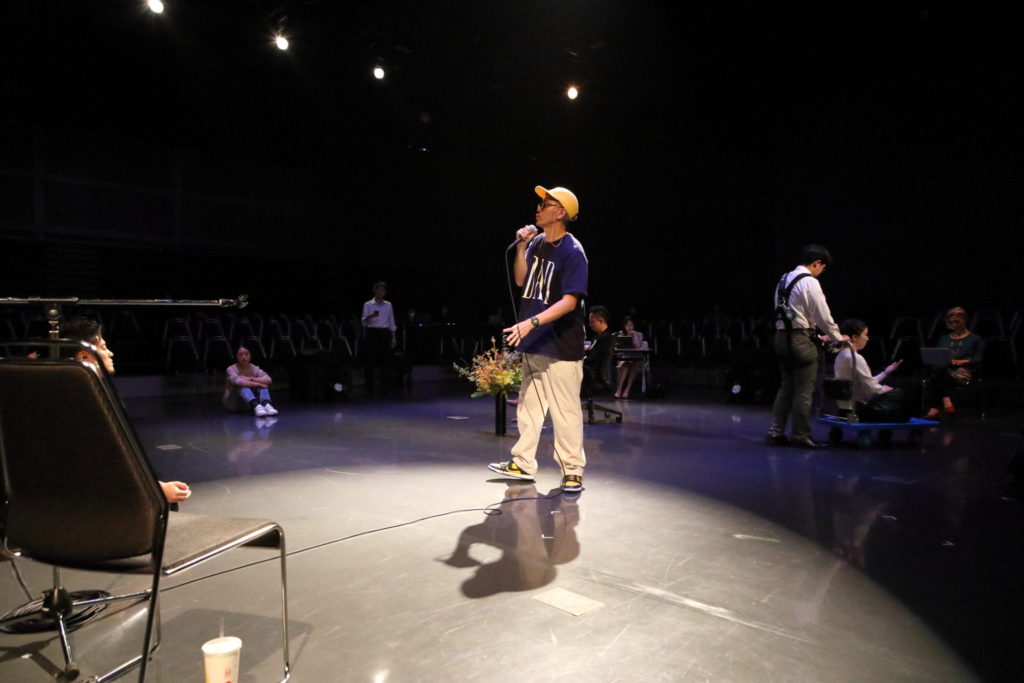
Photo by Kai Maetani
After watching Midori Kurata’s play “I Can/Can’t See You From Here Now,” this scene from memory came vividly to my mind. To tell the truth, I was reminded of it a little when I read these words by Kurata in the pamphlet: “I think there are times when we are saved by encounters with people we usually wouldn’t have crossed paths with.” With the 13 actors in the play actually working in the Otemachi, Marunouchi, and Yurakucho areas, which are also close to Shinbashi, it wouldn’t be surprising were we to have “crossed paths” somewhere in our daily lives. In fact, I did feel as if I had met and been saved by, albeit quite unilaterally, the strangers I passed in Shinbashi. The life stories that unfolded on the stage as each performer spoke, ran, sang, danced, and sometimes stood still, as if shouting out an endless stream of words, seemed to me—though this may sound strange—like evidence that affirmed the feelings I once held on the streets of Shimbashi.
I think the feeling of surprise that comes from watching this play stems from the disclosure of the depth and breadth of the struggles, suffering, and joys in the lives of the performers, all of whom are unnamed businesspeople. But the surprise also paradoxically highlights the persistence of my own bias. How can it be that people I pass on the train or in an office building, who would be invisible and unsympathetic to me, are living lives so similar to my own and those closest to me!
Of course, that’s somewhat of a tongue-in-cheek way of putting it. However, as city dwellers, we have no choice but to live our lives while dismissing the rich context of the overwhelming majority of strangers who enter our view. We would go mad otherwise. Anthropologist Robin Dunbar famously argued that the maximum number of people with whom one can maintain stable social relationships is about 150, which is a mere 0.001% of the some 14 million people in Tokyo. It can be said that the very structure of the city, which forces such indifference toward others, is insane. That may be why this play, especially when viewed by urbanites, evokes feelings of reconnection with the lives of people who live in the same city but whom we overlook on a daily basis.
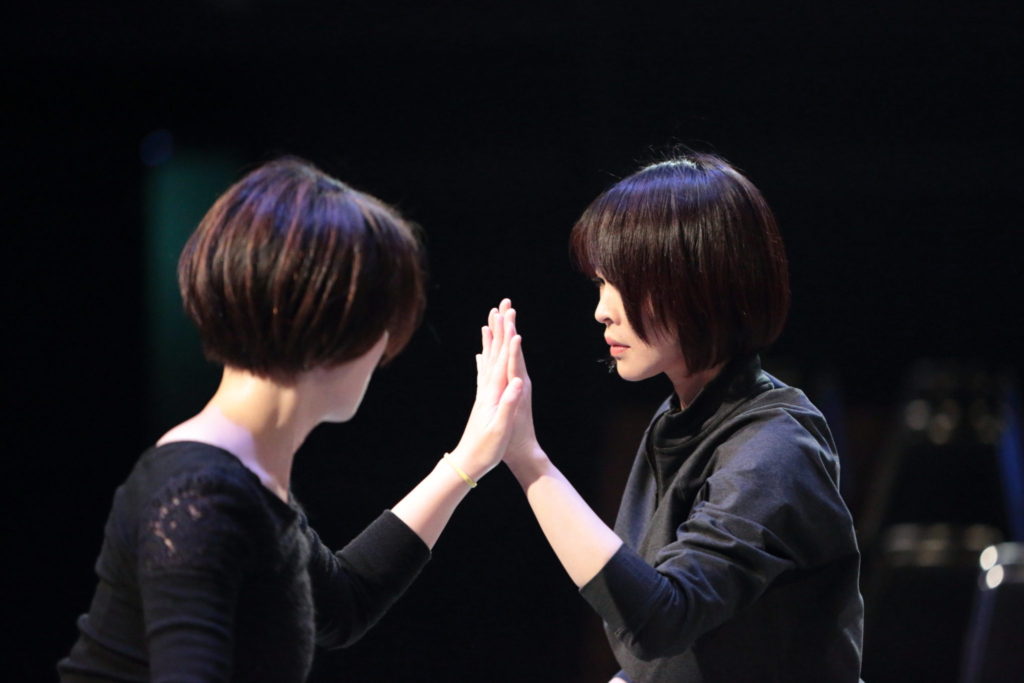
Photo by Kai Maetani
Why are we moved by the mere presence of unique life? It’s a theme dealt with not only in theater, but literature, poetry, music, and art as well, and I think it is a fundamental human feeling that cannot be summed up in one word. To me, it seems that there’s an opportunity here for a two-way connection to the theory of mind. The theory of mind refers to the psychological capacity to perceive that others have an autonomous mind just like one’s own. This capacity is thought essential for people to be able to cooperate with others. In this play, when those in the audience recognize that people whom they would normally overlook have rich lives of their own, the theory of mind is activated with regard to the performers as well as to city dwellers in general, which the performers symbolize. Conversely, the possibility arises that when you yourself are walking through the crowded streets of a business district, countless others may just recognize you as a being with a full life.
The factor of “elevation” is a topic of discussion within the field of wellbeing, which studies psychological fulfillment. The psychologist Jonathan Haidt defines elevation as “a warm, uplifting feeling that people experience when they see unexpected acts of human goodness, kindness, courage, or compassion. It makes a person want to help others and to become a better person himself or herself.”* I think the reason one feels elevated when watching Kurata and her group’s performance is because of the realization that the act of simply accepting one other, free from any given attributes or classifications, is not limited to a one-way gaze from the audience to the performers, but encompasses everyone present in the same space.
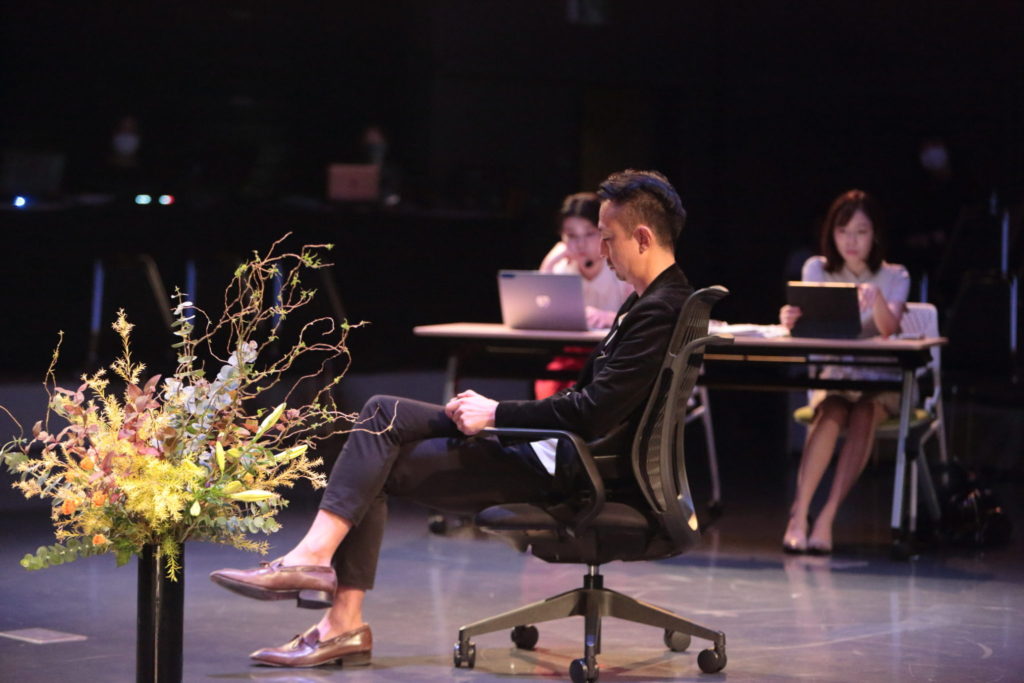
Photo by Kai Maetani
To classify strangers and treat them merely as “salarymen” or “office ladies” is, at root, a potentially violent act in the sense that it devalues the complexity and diversity each person contains. However, as we live our lives in modern cities and on social media, we are pressured to process information “efficiently” regarding a number of people that far exceeds our cognitive limits, to understand these masses from a detached perspective. This pressure can be called environmental, but it’s us humans who create that environment.
And in this Japanese society where politicians have continued to abandon their responsibility to provide public aid for the marginalized, calling for “self-responsibility” and “self-help” instead, where influencers and pundits reduce the complexities of the world to clever “bottom lines” and “refutations,” and where the gap between the haves and have-nots continues to widen, slogans like wellbeing and the Sustainable Development Goals, pushed by the government and corporations, ring hollow. If the academic discourse of describing human existence in terms of statistics and categories inadvertently colonizes our daily lives, we will ultimately suffer a continuous loss of perspective in our interactions with each other.
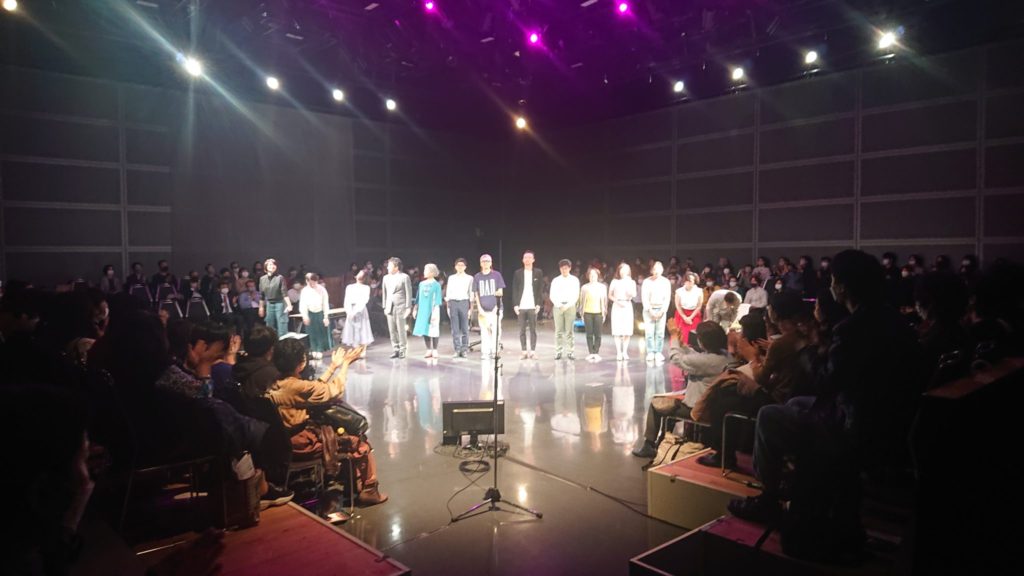
Midori Kurata not only directed and composed the performance; she was also present on stage. Seeing her standing next to the passionately engaged performers, I thought of Kazumi Yamashita’s manga work “Wonder Boy.” When asked about this protective gaze at an after-talk session to which I was also invited, Kurata replied that her morals didn’t allow her to merely direct; she had to be there on the stage, too. Reading interviews with Kurata regarding the performance, I learned that she took an editor-like role during the creative process, gently and patiently guiding the performers to express themselves autonomously by spending time talking with them and visiting their workplaces, all while maintaining a reasonable distance with them. Watching and learning about this approach of hers, I couldn’t help but feel elevated.
*Haidt, J. (2005). “Wired to be Inspired.” Berkeley: Greater Good Science Center, University of California
Translated by Ilmari Saarinen
INFORMATION
“I Can/Can’t See You From Here Now (Ima koko kara, anata no koto ga mieru/mienai)”
Date: 2022.11.23 - 25
Venue: Tokyo International Forum Hall D7
Presented by: OMY SDGs ACT5 Executive committee, bench Co.
Special co-operation by: YURAKUCHO ART URBANISM(YAU)
Direction: Midori Kurata
Cast: Yasuyo Ikuyama, Yuya Ishida, Atsuko Ogawa, Yuka Kikuchi, Masako Goto, Daisuke Sasaki, Shun Sato, Ryuma Takashima, Yoichiro Terao, Ayano Tsubo, Kaori Nakata, Shurin Miyahara, Junichiro Yatsugi / Midori Kurata
Produced by: bench Co.


